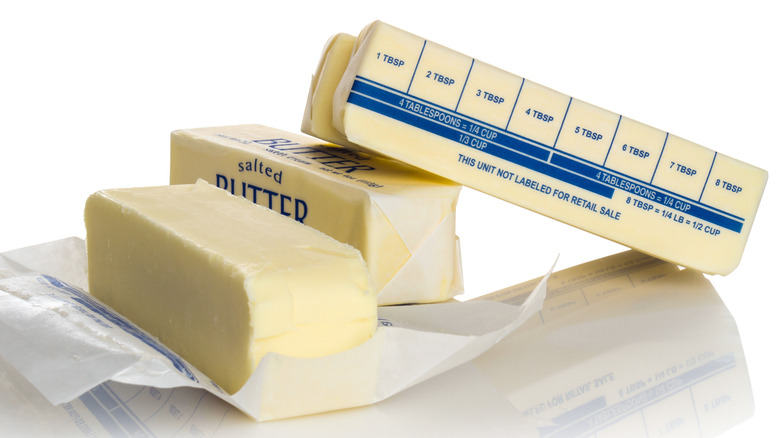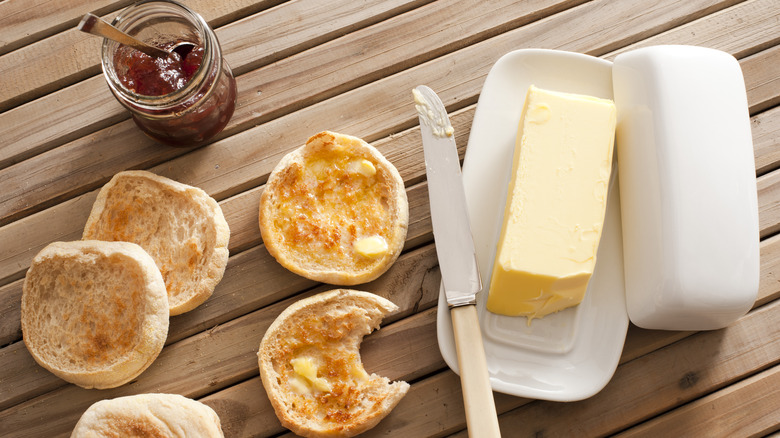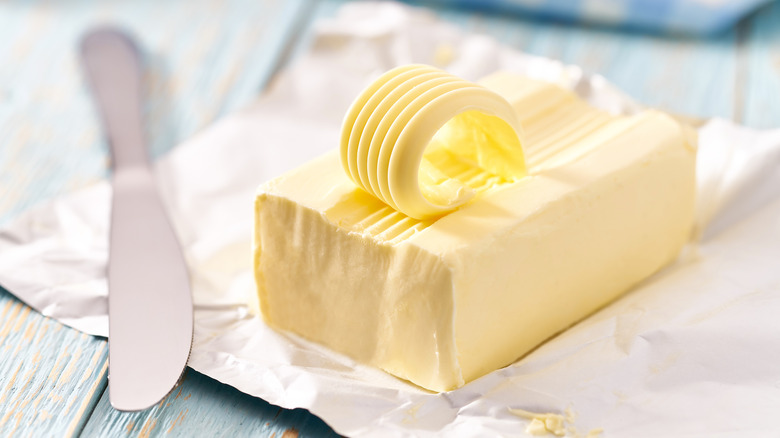The Pitfall To Avoid While Storing Butter On The Counter
Room-temperature butter is essential for baking, but it also makes buttering your morning toast or preparing a grilled cheese sandwich that much easier. As we bread-loving, carb-a-holics know, cold butter tears the surface of tender baked goods, leaving a crumbly mess (especially with croissants), so many of us prefer to store it on the counter.
While it's safe to leave butter at room temperature, the ambient temperature of your kitchen may prematurely turn it rancid. Leaving the butter on the counter in a hot kitchen or keeping it near a heat source like the stove or on top of the refrigerator can accelerate mold growth, forcing you to throw out an expensive stick of Plugrà before you are ready to say goodbye.
The Federal Department of Agriculture mandates that butter sold in the U.S. contains at least 80% milk fat — European-style and cultured butter has a greater percentage. Butter's high-fat content makes it more stable at room temperature, especially salted butter. However, there's an increased risk of it going bad since butter melts at 82 degrees Fahrenheit, causing the fat and water to separate, enabling a pathway for foodborne bacteria to multiply. If you want your butter to be waiting for you, not the other way around, there are some pitfalls to avoid. The most important one? Don't store it in metal.
Store butter in the proper container
Whether storing it on the counter or in the refrigerator, using the proper container is essential to prevent butter from going rancid or tasting off. Butter is highly susceptible to absorbing surrounding odors, so storing it near a basket of onions or where you cook fish could make the naked stick taste funky on your English muffin.
If using a butter dish, avoid metal ones, which causes the fat to oxidize quickly. In a nutshell, metal ions cause the oxidation of lipids (aka fat), which in turn causes that fat to spoil. Instead, choose a plastic or glass airtight container that fits the size and shape of your butter — since some will accommodate a ½-cup stick of butter, and others are meant for one-pound bricks.
Butter crocks are an excellent solution if you always keep butter on the counter. They are available in an array of colors and materials like ceramic or marble. The two-piece container lets you store room-temperature butter in the bell-shaped lid, which sits in a crock of water when not in use. The water creates an airtight seal, preserving the butter. When using a butter crock, it's essential to pack the softened butter firmly to avoid air pockets, change the water every few days, and keep the crock at room temperature to keep it fresh longer.
More tips for storing butter at room temperature
The kind of butter you use, your kitchen's temperature, how long it sits out, and what material the butter is stored in all play an essential role in preserving the delicious fat. If the butter (or margarine) is reduced fat or unsalted (affecting its pH), its ability to naturally inhibit bacteria growth is diminished. To be safe, store this butter type in the refrigerator or stick to salted.
At room temperature, butter can safely sit out for a few days. Since we all have different standards for what we consider "room temperature," it's important to note that we are referring to 67 and 70 degrees Fahrenheit. If your kitchen's ambient temperature exceeds that, keep the butter in the fridge, especially if you don't go through a stick of butter within three days. You can also cut off a few tablespoons to leave at room temperature and place the rest in the fridge or purchase mini ¼-cup sticks.
Air and sunlight can cause butter to spoil, so if you leave it at room temperature, remove it from its wrapper and place butter in an appropriate airtight container. Although wrapping it in plastic will prevent oxidization, it's best to use a butter dish or crock, which blocks its exposure to light.



